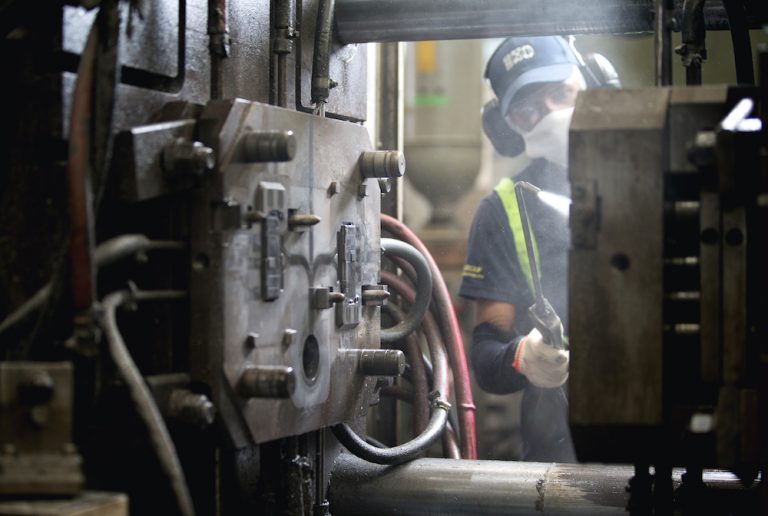
Precision Die Casting
What is Die Casting
Die casting is the process of forcing molten into a mould cavity under high pressure. In precision die casting, the mould cavity is usually made with two steel dies that have been created into desired shape by a machine.
At EKO, die castings are manufactured with non-ferrous metals such as aluminium, zinc, and tin-based alloys. The type of metal that is being cast determines the type of machine used (hot chamber/cold chamber) to make the cast.
Die casting is a manufacturing process that is suitable for high volume items. As metal dies and casting equipment make up a large part of capital costs, the incremental cost per item tends to be very low.
Our precision die-casting process ensures that the products that we manufacture have excellent surface finishing and good dimensional consistency with precise measurements.
Die Casting Material
Die casting is the process of forcing molten metal into a mould cavity under high pressure. In precision die casting, the mould cavity is usually made with two steel dies that have been created into the desired shape by a machine.
At EKO, die castings are manufactured with non-ferrous metals such as aluminium, zinc, and tin-based alloys. The type of metal that is being cast determines the type of machine used (hot chamber/cold chamber) to make the cast.


Die casting is a manufacturing process that is suitable for high volume items. As metal dies and casting equipment make up a large part of capital costs, the incremental cost per item tends to be very low.
Our precision die-casting process ensures that the products that we manufacture have excellent surface finishing and good dimensional consistency with precise measurements.
Aluminium Die Casting
Aluminium die casting alloys or so-called “ADC/LM: (follow with the code ADC12/LM1) are lightweight. It offers good corrosion resistance, ease of casting, good mechanical properties and dimensional stability.
It also has excellent shielding properties, high electrical conductivity and is durable enough to achieve high quality finishing characteristics.
Complete recycling of aluminium die castings is also possible. Many companies choose aluminium alloys because of its durability and lightweightedness.
Zinc Die Casting
Zinc or so-called “Zamak” have high strength and hardness with an excellent electrical conductivity. Apart from this, Zinc has characteristics such as high thermal conductivity, accuracy and stability during casting. It has an excellent thin wall capability resulting in the ability to achieve high quality finishing characteristic.
It is also possible for complete recycling when the zinc die casting is no longer usable.
Precision Die Casting Process

Clamping
The two halves of the die are clamped together with enough force to keep it secure when the metal is injected.

Injection
Molten metal is injected into the die. The transfer method of the metal depend on whether a hot chamber machine or cold chamber casting machine is used.

Cooling
The molten metal is allowed to cool and solidify when it enters the die cavity.

Ejection
Once the cooling time has passed, the two halves of the die will be opened and the casting is pushed out with an ejection mechanism

Trimming
Excess material will be trimmed from the casting.
Die casting has far-reaching applications. Manufacturing industries such as automobile, aerospace and power tools industries are all heavily reliant on the die casting processes.
Types of Die Casting
Hot Chamber Die Casting
In hot chamber die casting, the injection mechanism’s cylinder chamber is completely immersed in the molten metal. The direct immersion results in a fast, convenient foul injection that leads to high productions rates.
Hot chamber die casting removes the need to transfer metal from a separate furnace. It is a casting process that works well for items that use metals with low melting points such as zinc, lead and tin.
Cold Chamber Die Casting
In cold chamber die casting, the molten metal is ladled into the injection system. This means the injection mechanism is not immersed in molten metal.
Cold chamber die casting is generally slower than hot chamber die casting. However it is great for alloys with high melting temperatures such as brass, aluminium, and magnesium.
The type of die casting needed is dependent on the project or product and its application. Our team at EKO will ensure that the right process is used for your application.
The manufacturing industries are constantly chasing-there’s always a new technology promising to make manufacturing floors more efficient than ever. It also helps to keep abreast of technological developments and ensure that your business is taking advantage of the latest innovations to improve productivity.
Why Use Precision Die Casting
- It is efficient and economical for high volume production runs.
- It can create a broad range of complex shapes and components.
- Die casted parts have a long service life.
- Die casted parts have close tolerances, and dimensional accuracy.
- There are multiple finishing techniques.
- Automated processes guarantee consistency in the finished product.

Die Casting vs Other Manufacturing Processes
Die Casting vs Sand Casting
Die Casting vs Plastic Injection
Die Casting vs Forgin
Die Casting vs Screw Machining
Here at EKO, we do cast either in Aluminium or Zinc with our latest hot & cold chamber machine
Cold Chamber Casting
Hot Chamber Casting
AVAILABLE TONNAGES
- Toyo Casting Machine 125 Tonnage
- Toyo Casting Machine 250 Tonnage
- Toyo Casting Machine 250 Tonnage
- Toyo Casting Machine 250 Tonnage
- Producer 130 Tonnage
Surface Improvement & Finishing Process





